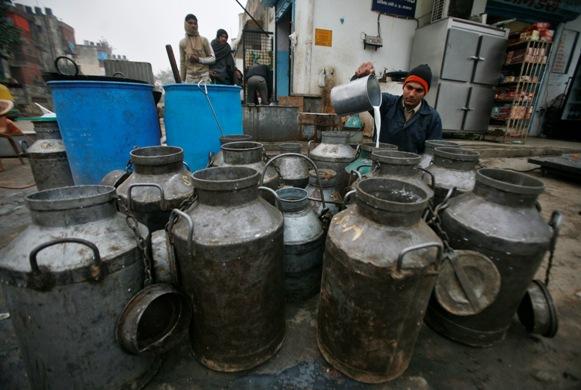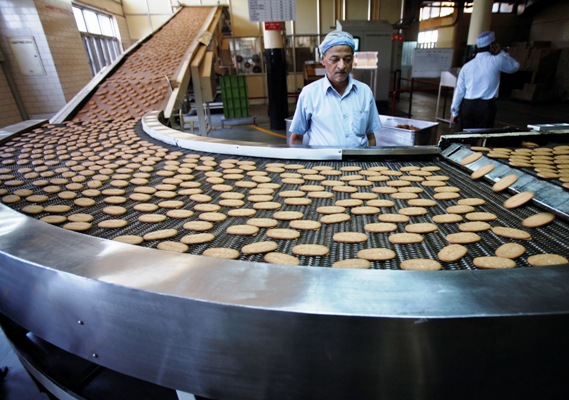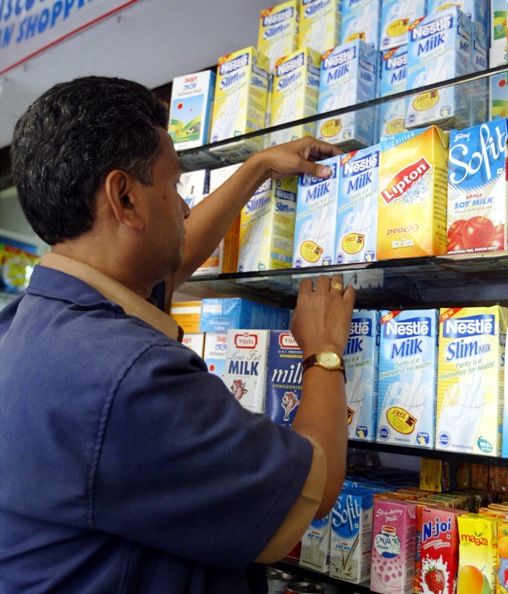Photographs: Parivartan Sharma/Reuters Rajendra Jadhav in Mumbai
India, the world's biggest milk producer, hopes to seize on a New Zealand dairy product contamination scare to increase its exports and add market share in China and other emerging Asian countries.
India's milk production is likely to rise almost 5 per cent in the year to next March to 133 million tonnes, said R G Chandramogan, managing director of Hatsun Agro Products Ltd, one of the country's leading milk powder exporters.
Traditionally, most of that production stays at home as a protein staple for a population of 1.2 billion, but with domestic demand pegged at around 128 million tonnes, there should be more milk available to make skimmed milk powder for export.
. . .
India to milk advantage from curbs on New Zealand dairy products
Image: A milkman pours milk into a container to deliver to shops in Noida, Uttar Pradesh.Photographs: Parivartan Sharma/Reuters
The Indian government also usually restricts overseas sales to keep a lid on local prices.
But, with more milk powder, a weaker rupee currency and Chinese restrictions on using some New Zealand products in the wake of Fonterra's whey powder concentrate contamination scare, India expects its SMP exports to jump by more than half to 100,000 tonnes this year, said RS Sodhi, managing director of Gujarat Cooperative Milk Marketing Federation Ltd, India's top milk product exporter and owner of Amul.
The latter is the nation's best-known milk and dairy products brand.
. . .
India to milk advantage from curbs on New Zealand dairy products
Image: A customer examines a packet of cheese in the processed dairy food section of a supermarket in Mumbai.Photographs: Vivek Prakash/Reuters
Referring to New Zealand's food safety issue, Sodhi said: "We don't have such a problem. This is a very good opportunity for India.
"Definitely our exports will rise this year."
Amul branded products won't be appearing in Chinese supermarkets just yet -- Indian supplies will go to milk product makers who then use their own packaging.
GCMMF expects to ship 25,000 tonnes of SMP this year - five times last year's levels.
"This year there is no (export) restriction and market conditions are better," said Sodhi.
. . .
India to milk advantage from curbs on New Zealand dairy products
Image: A worker stands next to a production line at the Britannia biscuit factory in New Delhi.Photographs: Adnan Abidi/Reuters
PEAK SEASON
Nearly 90 per cent of China's $1.9 billion in milk powder imports last year originated in New Zealand.
India's milk product exports are tiny in comparison -- just $230 million last year, mainly to south Asian countries and West Asia.
India only felt comfortable enough with its domestic supplies to lift an SMP export ban in June 2012.
"We are heading towards the flush season, so there will be more milk available for SMP. We are getting good export orders for SMP," said Vinayak Patil, chairman of the Maharashtra State Cooperative Milk Federation.
. . .
India to milk advantage from curbs on New Zealand dairy products
Image: A worker at a shopping mall adjusts packs of various milk products in Mumbai.Photographs: Sherwin Crasto SC/PB/Reuters
August marks the start of a 2-3 month peak milk production season in some Indian states.
Rising export prices are also boosting sales, especially with the rupee's weakness. The currency hit a record low of 61.80 to the dollar on Tuesday, and has lost a tenth of its value so far this year.
"SMP prices have risen more than 15 percent in six months in dollar terms," said an official at a Delhi-based co-operative dairy.
"With the rupee depreciation," he added, "SMP exports are now lucrative for dairies."







article